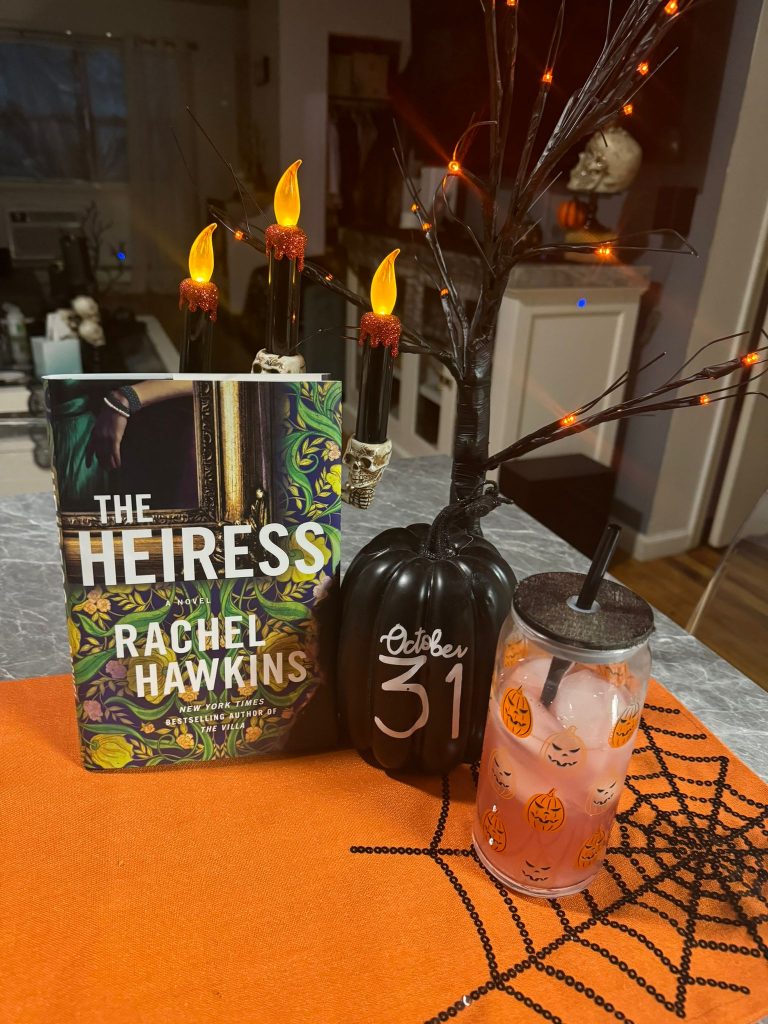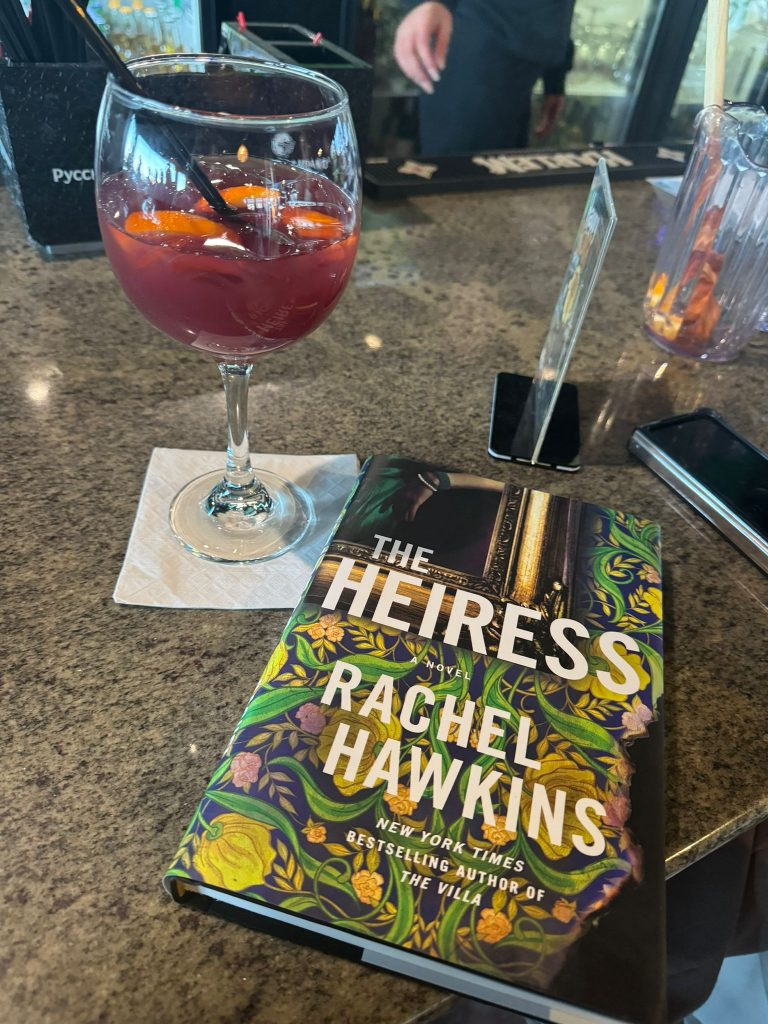
The Heiress

When Ruby McTavish Callahan Woodward Miller Kenmore dies, she’s not only North Carolina’s richest woman, she’s also its most notorious. The victim of a famous kidnapping as a child and a widow four times over, Ruby ruled the tiny town of Tavistock from Ashby House, her family’s estate high in the Blue Ridge mountains. In the aftermath of her death, that estate—along with a nine-figure fortune and the complicated legacy of being a McTavish—pass to her adopted son, Camden.
But to everyone’s surprise, Cam wants little to do with the house or the money—and even less to do with the surviving McTavishes. Instead, he rejects his inheritance, settling into a normal life as an English teacher in Colorado and marrying Jules, a woman just as eager to escape her own messy past.
Ten years later, Camden is a McTavish in name only, but a summons in the wake of his uncle’s death brings him and Jules back into the family fold at Ashby House. Its views are just as stunning as ever, its rooms just as elegant, but coming home reminds Cam why he was so quick to leave in the first place.
Jules, however, has other ideas, and the more she learns about Cam’s estranged family—and the twisted secrets they keep—the more determined she is for her husband to claim everything Ruby once intended for him to have.
But Ruby’s plans were always more complicated than they appeared. As Ashby House tightens its grip on Jules and Camden, questions about the infamous heiress come to light. Was there any truth to the persistent rumors following her disappearance as a girl? What really happened to those four husbands, who all died under mysterious circumstances? And why did she adopt Cam in the first place? Soon, Jules and Cam realize that an inheritance can entail far more than what’s written in a will—and that the bonds of family stretch far beyond the grave.
Ashby House
is the primary symbolic presence in the novel, representing the McTavish family culture and the isolation bought by their wealth. Its imposing, fortress-like facade highlights the family’s insulated entitlement and sense of protection. While Jules initially sees the house as a protective force, Cam views it as imprisonment, fearing he will be “swallowed up” and entangled in his family’s toxic dynamics. The house functions as a Gothic convention, mirroring the family’s moral decay. The McTavishes see it as a retreat from accountability, where they can “forget there’s a world outside,” but Cam sees it as a destructive entity. Its ultimate fate—burning down—is a necessary act that symbolizes the destruction of the family’s controlling and corrupted culture.
Ruby’s Portrait
is a powerful symbol of her enduring influence and power, even after her death. The portrait, which hangs prominently at the top of the stairs, forces anyone entering Ashby House to confront her presence. The emerald gown she wears layers the image with irony, as it was purchased during a honeymoon marred by her first husband’s abuse and subsequent murder. The portrait’s survival of the fire is narratively significant: although everything else about the McTavish family is incinerated, Ruby’s influence remains. Jules and Cam take the portrait into their new life, acknowledging that Ruby, regardless of her motives, was the force that brought them together. Her portrait is given a place of prominence in their new home, symbolizing their acceptance of her influence as they start anew.
Ruby’s Philanthropy
Ruby’s acts of philanthropy after each husband’s death serve as potent motifs, revealing her true feelings, guilt, and use of wealth to escape accountability. Her donations, which correspond to the circumstances of each murder, are a blend of dark humor, genuine love, and lack of remorse.
Duke (First Husband): She donates to his school, an act born of guilt and speculation about his abusive origins.
Hugh (Second Husband): The gazebo with electric fairy lights is an act of dark humor, memorializing his accidental electrocution and mocking his controlling nature.
Andrew (Third Husband): The sincere arts center is the only unironic gift, reflecting the true love she felt for him.
Roddy (Fourth Husband): The lack of a gift signifies her complete lack of guilt or attachment to him.
The pattern underscores Ruby’s confidence in using her money to alleviate her guilt and avoid legal repercussions.
About the author - Rachel Hawkins

Rachel Hawkins (born November 23, 1979) is the author of Hex Hall, a best-selling trilogy of young adult paranormal romance novels. She is from Dothan, Alabama. She also writes as Erin Sterling.
Hawkins was born in Newport News, Virginia, moved to Dothan, Alabama at a young age, graduated from Houston Academy in 1998, and received a degree in English literature from Auburn University in 2002. She began writing her first novel, Hex Hall, while working as an English teacher at Sparkman High School. As of 2021, Hawkins lives with her family in Auburn, Alabama
Books
Hex Hall
- Hex Hall (2010)
- Demonglass (2011)
- Spell Bound (2012)
- School Spirits (2013)
- Short story: “A Very Hexy Valentine’s Day” (2013)
Rebel Belle trilogy
- Rebel Belle (2014)
- Miss Mayhem (2015)
- Lady Renegades (2016)
Royals Series
- Prince Charming (2018) (first published as Royals)[5]
- Her Royal Highness (2019)
Short stories
- “Eyes in the Dark”, Defy the Dark, ed. Saundra Mitchell (2013)
- “The Key”, Grim, ed. Christine Johnson (2014)
Middle grade fiction
- Journey’s End (2016)
- Ruby & Olivia (2017)
Adult fiction
- The Wife Upstairs (2021)
- The Ex Hex (2021) (writing as Erin Sterling)
- The Kiss Curse (2022) (writing as Erin Sterling)
- Reckless Girls (2022)
- The Villa (2023)
Audiobooks
Beatrix Greene, Serial Box (2020) (writing with Ash Parsons and Vicky Alvear Shecter; first published as The Haunting of Beatrix Greene)





Plot Summary
The Heiress is a psychological thriller that alternates between the first-person perspectives of Jules Brewster and her husband, Cam McTavish, with interspersed letters from Cam’s adoptive, recently deceased mother, Ruby McTavish.
The McTavish Inheritance
The novel opens with Cam reluctantly inheriting the vast McTavish fortune and the dilapidated family estate, Ashby House, after his adoptive mother, Ruby, dies. Cam and his wife, Jules, travel to North Carolina, where they are immediately confronted by Cam’s snobbish, manipulative relatives: his grandmother, Nelle, and his cousins, Ben and Libby. Cam has avoided the family for 10 years, and while Jules is excited by the prospect of wealth, Cam is wary of his entitled family.
The cousins, desperate for the money, reveal they have DNA evidence proving Ruby was not a McTavish but was Dora Darnell, a child who went missing and was later sold to the McTavish family after the real Ruby disappeared. When Ben and Libby threaten to investigate Ruby’s death, Cam agrees to leave the inheritance. He confesses to Jules that he allowed Ruby to die from an overdose, choosing to be free of her manipulative presence rather than calling for help.
Secrets and Lies
The day after Cam’s confession, Nelle dies, and Ashby House is set on fire. Jules escapes, but Ben and Libby die in the blaze. Jules tells the police that Ben started the fire, but Cam realizes Jules is responsible for Ben’s death and is protecting him from the consequences of his confession. He chooses to say nothing, hoping she will eventually share the truth.
The truth is revealed in Ruby’s letters. She was an unrepentant serial killer (“Mrs. Killmore”) who murdered her four husbands, using the McTavish name to evade justice. After discovering she was actually Dora Darnell, whose parents had sold her to the McTavishes, she decided to take the McTavish fortune away from the family that bought her. She adopted Cam and made him her sole heir.
The Ultimate Twist
The final letters reveal a shocking conspiracy: Ruby’s correspondent is Jules, the granddaughter of Ruby’s sister, Claire Darnell. Together, Ruby and Jules planned to give the McTavish fortune to Cam (who was not a McTavish) and share the wealth with the Darnell family, with Jules initiating a relationship with Cam.
In the final pages, Jules believes Cam is unaware of her manipulation, but Cam reveals that he has known about the scheme all along. However, he also confesses that his love for her is real, completing their complex, destiny-laden relationship.
Character Analysis
Jules Brewster / Caitlin Julianne Darnell
is one of the novel’s protagonists, later revealed to be Caitlin Darnell, granddaughter of Ruby’s sister. Defining herself as “Florida trailer park trash,” she possesses a brash, straightforward manner that makes her uniquely qualified to confront the snobbery of the McTavish family. Her insouciance and blunt refusal to be cowed help Cam maintain his perspective and chase away the shadows of his past.
Jules’s arc traces her shift from assuming she could easily conquer the McTavish family to realizing the depth of their corruption. She rationalizes manipulating the situation to reclaim the house, believing Cam needs her to do the “shady things” that would tarnish his shine. Her final act of burning down Ashby House is a radical acceptance of The Influence of Family Culture on the Individual, recognizing that the toxic environment had to be destroyed for her and Cam to build a healthy new family.
Camden McTavish
Cam is the novel’s other protagonist. He is quiet and unassuming, characterized by a profound understatement that masks his resilience. He is defined by his choice to walk away from a hundred-million-dollar fortune and his family’s influence for his emotional well-being. Cam’s journey revolves around Rediscovering the Past From a New Perspective. He is surprisingly insightful, knowing all along that Jules had an agenda when they met but recognizing that her love for him is genuine. By the end, he realizes that neither the McTavishes nor his birth mother are his family; Jules is, a realization that frees him to finally rebuild his life.
Ruby McTavish / Dora Darnell
is the deceased matriarch whose larger-than-life portrait and letters drive the novel’s plot. Her life is marked by trauma: she was a victim of a crime, sold by her parents to the McTavish family to replace their dead child. This trauma led her to become an unrepentant serial killer (“Mrs. Killmore”), murdering all four of her husbands and using the McTavish name and wealth to escape accountability. Ruby’s story highlights The Influence of Family Culture on the Individual, as she became convinced that her own murderous tendencies were rooted in her traumatic childhood. Her final act was to orchestrate a plan with Jules to redistribute the family’s ill-gotten fortune.
Ben McTavish
is Cam’s cousin, an estate lawyer whose entire career has been dedicated to finding a way to screw Cam out of his inheritance. He is Cam’s foil, representing what Cam could have become had he not consciously distanced himself from the family’s entitlement. Ben is highly susceptible to the McTavish snobbery, unable to process Jules’s directness and mocking behavior. He embodies The Influence of Family Culture on the Individual, showing how entitlement can manifest as jealousy and manipulation.
Libby McTavish
is Ben’s sister, portrayed as a “fuckup” whose attempts at careers and marriage have all failed. Her seemingly polished social media persona quickly dissolves upon meeting Jules, serving as the first indicator to Jules that The McTavish family is not what it seems. Libby is a foil for Jules; her entitlement and snobbery contrast sharply with Jules’s forthrightness and resilience. Her past attempt to seduce Cam for the family’s financial gain highlights the extreme lengths the McTavishes will go to maintain their wealth.
Nelle McTavish
is Ruby’s younger sister, characterized as cruel, snobbish, and bitter. Her lifelong envy of Ruby is rooted in the fact that she was conceived to replace the real Ruby but was marginalized when the adopted Ruby/Dora showed up. Nelle is deeply invested in her identity as the matriarch of Ashby House, and she resents both Ruby and Jules for challenging that status. She spent her life fostering competition between Cam and Ben, demonstrating how generational competition and bitterness are sustained within the family culture.
Bookclub Questions
Initial Impressions
How does The Heiress compare to other psychological thrillers you’ve read, whether by other authors or by Rachel Hawkins herself?
Consider your immediate and evolving reactions to Ruby, Jules, and Cam. Which characters did you find most sympathetic or connect with, and which did you actively dislike or disapprove of?
Personal Reflection and Connection
Defining Goodness: The novel’s heroes, Jules and Cam, are morally ambiguous. Did the story’s final twists and the resolution challenge your personal concept of what constitutes a “good person”?
Family and Truth: How did the novel’s complex, often toxic, portrayal of family culture resonate with you? Did you find any truths about family dynamics that you agree with or, conversely, any perspectives you would dispute?
Memory vs. Reality: Cam revisits his past and finds a disparity between his memories and reality. How do you feel about the role of perspective and memory in shaping personal history? How confident are you that your own memories are completely accurate?
The Nature of Love: Jules’s love for Cam developed despite their relationship’s manipulative origins. What is Jules’s ultimate definition of love? Do you agree or disagree with her, and why?
Societal and Cultural Context
Class Dynamics: Class is a major factor in the novel. What does the book suggest about class dynamics and entitlement in the contemporary US? Do you feel its depiction of the divide between the wealthy McTavishes and the working-class Jules is accurate?
Abuse and Intervention: The novel depicts various forms of abusive behavior (emotional, physical, and financial). Where does the story suggest such behavior originates? Given this, what societal interventions might help curb the cycle of abuse?
Literary Analysis
Gothic Conventions: How does the author utilize Gothic conventions (e.g., the decaying mansion, dark secrets, isolated setting) in The Heiress? Did the novel simply follow these tropes, or did it subvert or modernize them in any way?
Perspective and Tension: The story relies on alternating perspectives and the eventual revelation that Jules is an unreliable narrator. How does this technique create the tension, suspense, and dramatic plot twists characteristic of a psychological thriller?
Ruby’s Transformation: Analyze Ruby’s character arc through her letters. How does your perspective on her change as you learn about her trauma, her discovery of her true identity, and her subsequent murders?
Ashby House as a Character: Discuss the thematic role of Ashby House. How does the physical house and its grounds function in the narrative, and why was its destruction necessary for Cam and Jules to achieve a “fresh start”?
Creative Engagement
Book Soundtrack: Imagine a soundtrack for The Heiress. Create a short playlist that assigns specific songs to pivotal scenes (e.g., Cam’s confession, the final confrontation). What mood or suspense are you trying to convey with your choices?
Gothic Rewrite: The novel is a modern Gothic story. Choose a chapter and rewrite it, changing the setting to the late 18th or early 19th century, reflecting classic Gothic literature. How does the shift in setting change the story’s emotional impact, and what elements remain surprisingly consistent?

The Midnight Feast
You May Also Like

Homecoming
May 31, 2023
Wish You Were Here
May 11, 2023







